 This large size (26 inches high
or more) cultivar was registered by
Connie Williams, the daughter of
Frances Williams of Massachusetts in 1986. It
was "discovered" in a Connecticut nursery in 1936 by
Frances and is
considered a sport of
H. 'Elegans'.
This cultivar was once known as H. sieblodiana 'Aureomarginata'
before being renamed. This large size (26 inches high
or more) cultivar was registered by
Connie Williams, the daughter of
Frances Williams of Massachusetts in 1986. It
was "discovered" in a Connecticut nursery in 1936 by
Frances and is
considered a sport of
H. 'Elegans'.
This cultivar was once known as H. sieblodiana 'Aureomarginata'
before being renamed.
The leaves have thick
substance, are heavily corrugated, have a deeply lobed
base and a distinct tip. It bears large clusters of
near white flowers from mid-June into July. Unfortunately, this
cultivar is susceptible to spring desiccation burn (see
below).

According to
The Hostapedia
by
Mark Zilis (2009), this cultivar "...is named for the
most influential
person in the modern history of hostas. Her correspondence with
other collectors, hybridizers, and botanists from the 1930s
until her death in 1969 fanned the flames of interest in hostas
and let to the formation of
The American Hosta Society. She also
developed some of the first hosta cultivars including 'Green
Piecrust', 'Louisa', 'Sweet Susan' and 'Frances Williams'."
 The New Encyclopedia of Hostasby
Diana
Grenfell (2009) states: "Site in light to moderate shade to prevent the
leaf edges from scorching, but they will scorch in the warmest
climates even in full shade. Impressive in a large container but
needs dividing every three years...Slow to establish but nonetheless
among the most popular hosta ever introduced. Breeding whit this
cultivar often produces streaked offspring." The New Encyclopedia of Hostasby
Diana
Grenfell (2009) states: "Site in light to moderate shade to prevent the
leaf edges from scorching, but they will scorch in the warmest
climates even in full shade. Impressive in a large container but
needs dividing every three years...Slow to establish but nonetheless
among the most popular hosta ever introduced. Breeding whit this
cultivar often produces streaked offspring."
This cultivar has been awarded the Royal Horticultural Society's
Award of Garden Merit in the
UK. It was the Winner of the 1986 Alex J. Summers
Distinguished Merit Hosta Award.
It may have been sold at
one time as Mackwoods No. 19.
-0200.jpg)


An article by W. George Schmid in
The
Hosta Journal (1985 Vol. 16) says that, "The other
German hosta of great interest is H. 'Semperaurea'...it is the most
magnificent golden-leaved hosta I have seen...said to have come from
Japan in
the 1930's, and, therefore, there would have existed a golden-margined form of
H. 'Sieboldiana' -- which we now call H. 'Frances Williams' -- in Japan during
that time."
Alex
Summers in
The
Hosta Journal (1995 Vol. 26 No. 2) writes, "H.
'Frances Williams' was registered...without detailed description or photos...the
plant was discovered in 1936 by Mrs. Frances Williams...in rows of H. 'Elegans'
at Bristol Nurseries in Bristol, Connecticut...Frances
Williams sent a division to the
University Botanic Garden in Oxford,
England in
1959. It was named by George Robinson at a Royal Horticultural Society lecture
on variegated plants."

A second article by Alex
Summers in
The
Hosta Journal (1995 Vol. 26 No. 2) was titled, "Hosta
'Frances Williams': A New Look at an Old Favorite". The main premise of the
piece was that over the long history of H. 'Frances Williams' which was
discovered in 1936, the plant sold by that name in recent decades is actually H.
'Aurora Borealis'. He claimed to have a clump of the original Williams' plant
which he named 'Bristol Frances Williams' to indicate that it is the one found
by Frances
Williams in 1936 at a nursery in Bristol, CT. The plant known as H. 'Aurora
Borealis' came from a hosta that
Chet Tompkins' mother, Cynthia received from
England in 1924 and later named by
Thelma Rudolph of Illinois
according to Summers.
An article about H. 'Great Expectations'
written by Warren I. Pollock in
The
Hosta Journal (2000 Vol. 31 No. 1) reports that
the originator,
John
Bond of England, wrote, "I became aware of an obvious sport on a substantial clump of
H. 'Elegans'
...in the rhododendron species collection in the Valley
Gardens in Windsor Great Park during the early 1980s. After a year or so I
decided to remove this sport for it was clearly promising to say the least...The
three "cuttings" were carefully planted in a sheltered corner of my own
garden...The following spring produced three nice little plants...Rightly or
wrongly I gave Paul Aden [Baldwin, New York] one of my plants and the remaining
two were transferred to the
Savill Garden from where sadly they were both
stolen!...So that is the very simple story and explains that there was no
mysterious breeding programme and also that H. 'Frances Williams' had no part to
play."
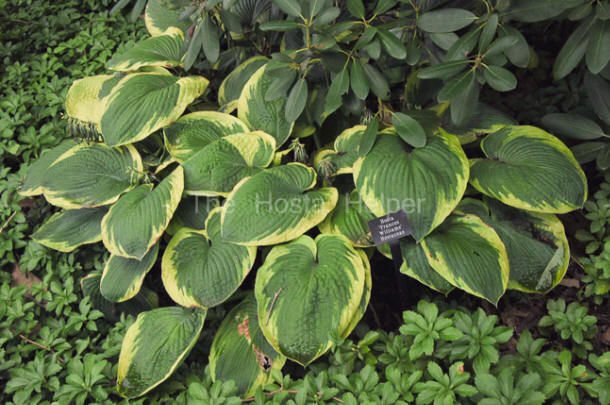

|
 An article by
Warren I. Pollack in
The
Hosta Journal (2020 Vol. 51 No. 1) titled
Doppelgänger Hostas: Fancy Name for
Look-alike Hostas, included a long list of hostas
which various hostaphiles, published articles or other sources have
indicated "look" the same. Some of these are, in fact, the same
plant with two or more different names. Others are hostas that vary
in some minor trait which is not immediately discernable to the
casual observer such as seasonal color variations, bloom traits, ploidy, etc. So, as Warren mentions, hostaphiles may differ as to the
plants listed but then, their opinions are based on visual observations and interpretations. An article by
Warren I. Pollack in
The
Hosta Journal (2020 Vol. 51 No. 1) titled
Doppelgänger Hostas: Fancy Name for
Look-alike Hostas, included a long list of hostas
which various hostaphiles, published articles or other sources have
indicated "look" the same. Some of these are, in fact, the same
plant with two or more different names. Others are hostas that vary
in some minor trait which is not immediately discernable to the
casual observer such as seasonal color variations, bloom traits, ploidy, etc. So, as Warren mentions, hostaphiles may differ as to the
plants listed but then, their opinions are based on visual observations and interpretations. |
| |
 H.
'Aurora
Borealis', H. 'Fleeta
Brownell Woodruffe', H. 'Frances
Williams', H. 'Maple
Leaf', H. 'Olive
Bailey Langdon' and
H. 'Samurai'. H.
'Aurora
Borealis', H. 'Fleeta
Brownell Woodruffe', H. 'Frances
Williams', H. 'Maple
Leaf', H. 'Olive
Bailey Langdon' and
H. 'Samurai'. |
|
|

Bob Solberg (nurseryman, noted hybridizer and past president of
The American Hosta Society ) in
The
Hosta Journal (2000 Vol. 31 No. 1) states that, in his
opinion, the Top 10 Hostas of the past Millenium would be:
 In
The
Hosta Journal (2001 Vol. 32 No. 1),
Tom Micheletti,
former President of The American Hosta Society took on the task of listing the
"Classic Hosta Cultivars" through the year 2003. He decided to divide these into
categories including: Green,
Blue,
Yellow (Gold,
White-Margined,
Yellow-Margined,
White Medio-Variegated
and Yellow Medio-Variegated, In
The
Hosta Journal (2001 Vol. 32 No. 1),
Tom Micheletti,
former President of The American Hosta Society took on the task of listing the
"Classic Hosta Cultivars" through the year 2003. He decided to divide these into
categories including: Green,
Blue,
Yellow (Gold,
White-Margined,
Yellow-Margined,
White Medio-Variegated
and Yellow Medio-Variegated,
While there are fewer yellow-margined
hostas, there are still some timeless beauties.
| Classic
Yellow-Margined Hostas |
- H. 'Abiqua Moonbeam' is the green-centered sport of H.
'August Moon' and surely shines in the garden.
- H. 'Alvatine Taylor' is a large blue-leaved hosta with gold
margins that don't exhibit the characteristic burning of
gold-leaved forms of
H. 'Sieboldiana'.
- H. 'Aurora Borealis' is one of the many similar cultivars in
this group. H. 'Frances Williams' has been one of the most
imitated of the classic hostas, after all she was the first of
over a dozen named, similar gold-margined sports from H. 'Elegans'
. Each one is reported to be an
improvement. Claims include not burning as much on the gold
portion of the leaf, improved flowering or showier variegation.
In any case, it is difficult to distinguish these cultivars.
- H. 'Carnival' is a
Lachman hybrid which features dark-green
leaves and wide irregular gold margins.
- H. 'Don Stevens' has pointed green leaves with creamy-yellow
margins.
|
- H. 'Fortunei Aureomarginata' is an oldie that still is not
to be outdone with its dark-green leaves and golden margins.
- H. 'Golden Tiara' has produced a whole series of sports, as
previously noted, one of which is H. 'Grand Tiara' with wider
gold margins. H. 'Grand Tiara' also has produced a whole series
of sports. The Tiaras all have a fine display of light-purple
flowers that may re-bloom if deadheaded.
- H. 'Green Gold' is one of the early gold-margined hostas.
- H. montana 'Aureomarginata' - as showy as it gets!
- H. 'Radiant Edger' is a dense sport of
H. 'Gold Edger' has
an attractive blend of green with gold.
- H. 'Tokudama
Flavocircinalis' is the gold-margined sport of
H. 'Tokudama' and while not as large as
H. 'Frances Williams',
doesn't exhibit the typical burning of the gold margins.
|
|
This is quite an extensive list of
distinctive cultivars. Many have been popular either with gardeners,
landscapers and collectors for over 25 years...Their timeless beauty
is why they are still kicking after all these years. |
-0201.jpg) |
 |
|
An article by noted hybridizer and nurseryman
Tony Avent in
The
Hosta Journal (2006 Vol. 37 No. 2) contained his brief
opinions on how to improve hostas considered to be
of Top 25 caliber (as of 2006 anyway):
|
- H. 'Sum and Substance' : Needs brighter yellow foliage, more
rigid scape.
- H. 'Sagae': Very slow to finish in pots; takes two seasons
to get a good edge.
- H. 'Great Expectations' : Great in open shade or morning sun
but hates dark shade.
- H. 'June': Slow to look mature in containers and in the
ground.
- H. 'Paul's Glory': Very difficult to get to come true in
tissue culture.
- H. 'Guacamole': Better foliage color contrast needed.
- H. 'Patriot' : Needs to finish off in containers faster.
- H. montana 'Aureomarginata': Needs to emerge later to avoid
frosts
- H. 'Gold Standard' : Yellow color could emerge and stay
brighter.
- H. 'Regal Splendor': Takes several seasons to develop a nice
wide edge.
- H. 'Frances Williams' : Foliage burns.
- H. 'Blue Angel' : Foliage could be much bluer and hold color.
|
- H. 'Krossa Regal': Needs shorter and more attractive scape.
- H. 'Fragrant Bouquet': Foliage color combination has little
market appeal.
- H. 'Whirlwind': Central leaf color fades.
- H. 'Love Pat': Could be faster-growing.
- H. 'Halcyon' : Could be faster-growing.
- H. 'Sun Power' : O.K. as is.
- H. 'Inniswood': Could be faster to marketable-size finish
crop.
- H. 'Striptease': Needs to be more stable.
- H. 'On Stage': Leaf color could hold longer; slow in
containers.
- H. 'Spilt Milk': Leaf pattern could be more vivid, and it
grows slowly.
- H. 'Fire and Ice': Could be more vigorous.
- H. 'Pandora's Box': Needs more heat-tolerance.
- H. 'Elegans': Needs bluer foliage that lasts into the
summer.
|
A Photo Essay by Steve Chamberlain in
The
Hostta Journal (2010 Vol. 41 No. 1) makes comments about
H. 'Jack of Diamonds', "Robert Savory registered this
H. 'Sieboldiana' hybrid in
1985. Although smaller in both leaf size and ultimate clump size than 'Frances
Williams', it shows all the desirable qualities of this famous cultivar."



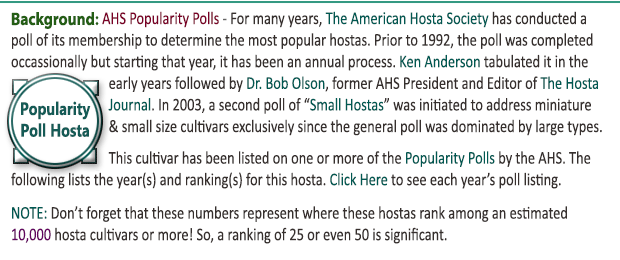 |
 |
 |
 |
| 16 |
9.9 |
1975 #5
1984 #1
1985 #1
1990 #9 |
1991 #8
1992 #8
1993 #12
1994 #6 |
1995 #5
1997 #10
1998 #12
1999 #16 |
2000 #13
2001 #11
2002 #20
2003 #23 |
|
|
|


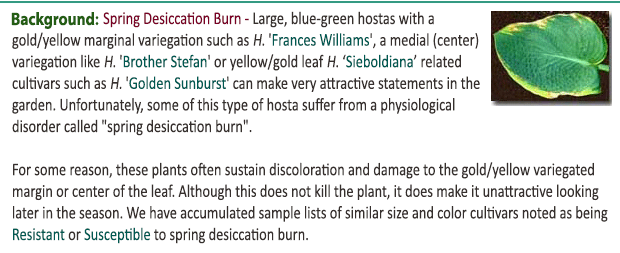

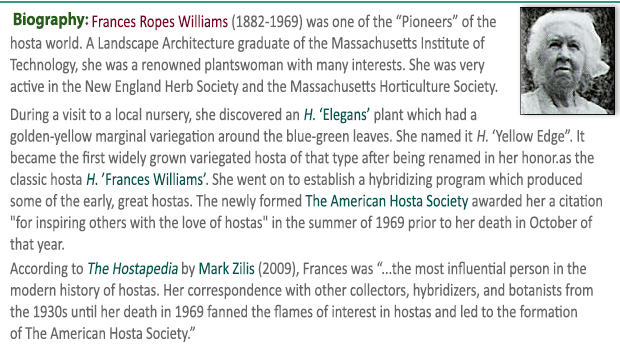



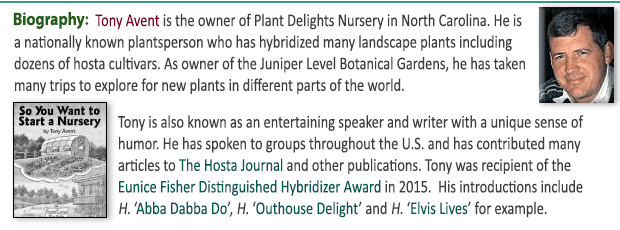







|



